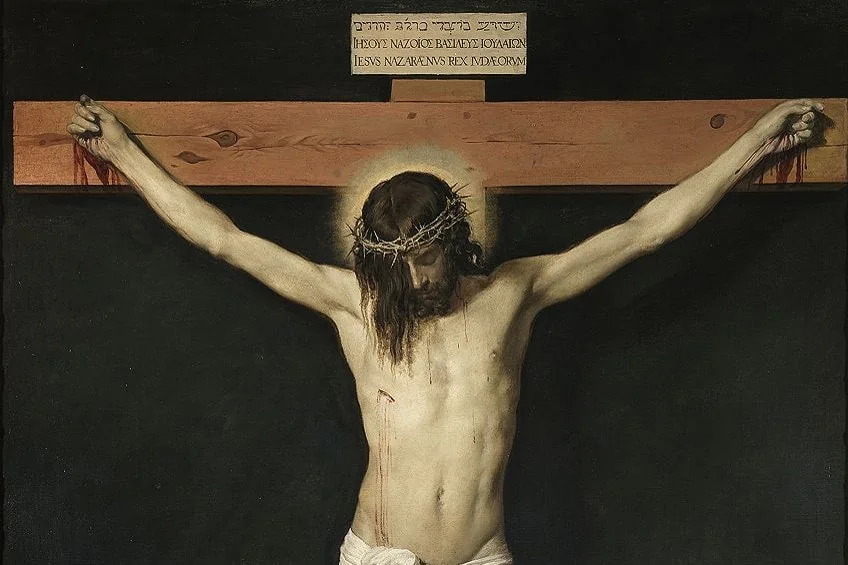Famous Paintings of Jesus – The Top Jesus Paintings in Art History
For thousands of years, Jesus has been portrayed in art in numerous ways, depicting and narrating the events during the life of Jesus on earth. The artworks are created in many different mediums from frescos to book illustrations. Most of the portraits and artworks of Jesus are in western churches. The most common subject in these paintings of Christ is based on the birth of Jesus, and the events leading to his crucifixion, his crucifixion, and his resurrection. This article will be going into the particulars about 10 paintings and artworks of Christ.
Contents
- 1 Jesus in Art: Why Is He Painted as a White European?
- 2 Ten of the Most Famous Paintings of Jesus
- 2.1 Ognissanti Madonna (1310) by Giotto di Bondone
- 2.2 Descent from the Cross (1435) by Rogier van der Weyden
- 2.3 Baptism of Christ (1470 – 1475) by Andrea del Verrocchio and Leonardo da Vinci
- 2.4 The Man of Sorrows in the Arms of a Virgin (1475 – 1479) by Hans Memling
- 2.5 The Last Supper (1495 – 1498) by Leonardo da Vinci
- 2.6 Disputation of the Holy Sacrament (1509 – 1510) by Raphael
- 2.7 Salvator Mundi (c. 1510) by Leonardo da Vinci
- 2.8 Christ Carrying the Cross (1577 – 1587) by El Greco
- 2.9 Christ Crucified (1632) by Diego Velázquez
- 2.10 Christ in the Realm of the Dead (1891 – 1894) by Joakim Skovgaard
- 3 Frequently Asked Questions
Jesus in Art: Why Is He Painted as a White European?
Jesus in art has been depicted for several centuries, with his appearance being altered several times. Jesus was mainly depicted in art as a white European male. The New Testament gives little information about the appearance of Jesus, with it only stating him having a bronze complexion.
Words used to describe the appearance of Jesus are more spiritual and less physical as he is described as more of a God than a human.
In the Bible, the color white is frequently associated with purity. This relationship could have to do with the representation of Jesus as a white man, however, the link between the color white and purity has been put to wrong use for ages to give grounds for racism.

After Jesus’ death, for several centuries Christians had to practice their religion and represent their beliefs with secret symbols otherwise they were to be persecuted by the Roman Empire. This however led to no real depictions of what Jesus from the time accurately looked like.
In the 6th century, Byzantine artists began to depict Jesus as a white male with facial hair and long middle-parted hair, even though he is depicted to have a bronze complexion in the Bible.
Byzantine artists also depicted Jesus as a passive leader when in fact he was quite outspoken about helping others. The Romans altered his appearance to be a more passive white-skinned male as a better-suited deity in the Roman mind’s eye. This is directly attributed to the white Jesus that we commonly see today in art.
Ten of the Most Famous Paintings of Jesus
There are hundreds of paintings of Jesus with deep symbolism and meaning. These paintings of Jesus still to this day are used and admired by many. Below, we will be going into detail about 10 of the most well-known paintings of Jesus.
Ognissanti Madonna (1310) by Giotto di Bondone
| Artist | Giotto di Bondone (1266 – 1337) |
| Date Painted | 1310 |
| Medium | Tempera on panel |
| Dimensions (cm) | 325 x 204 |
| Where It Is Currently Housed | Uffizi Gallery, Florence |
| Actual Price | Unknown |
Madonna Enthroned, also known as the Ognissanti Madonna, is a painting created by Giotto di Bondone, who was an Italian late medieval artist. The painting consists of the traditional Christian subject Virgin Mary with Christ as a child seated on her lap. Saints and angels are seen surrounding them on their left and right.
This painting was incredibly influential as it was the precursor to the Renaissance art era. This painting consists of many details that would later be seen throughout Renaissance art.
It was known as the first painting of the Renaissance art era due to its moving away from the rules of the gothic art era. Ognissanti Madonna was completed by Giotto in Florence, Italy. the artwork was created for Ognissanti Church in Florence. Ognissanti Madonna was one of several artworks created for the church. This artwork was created specifically for the high altar.
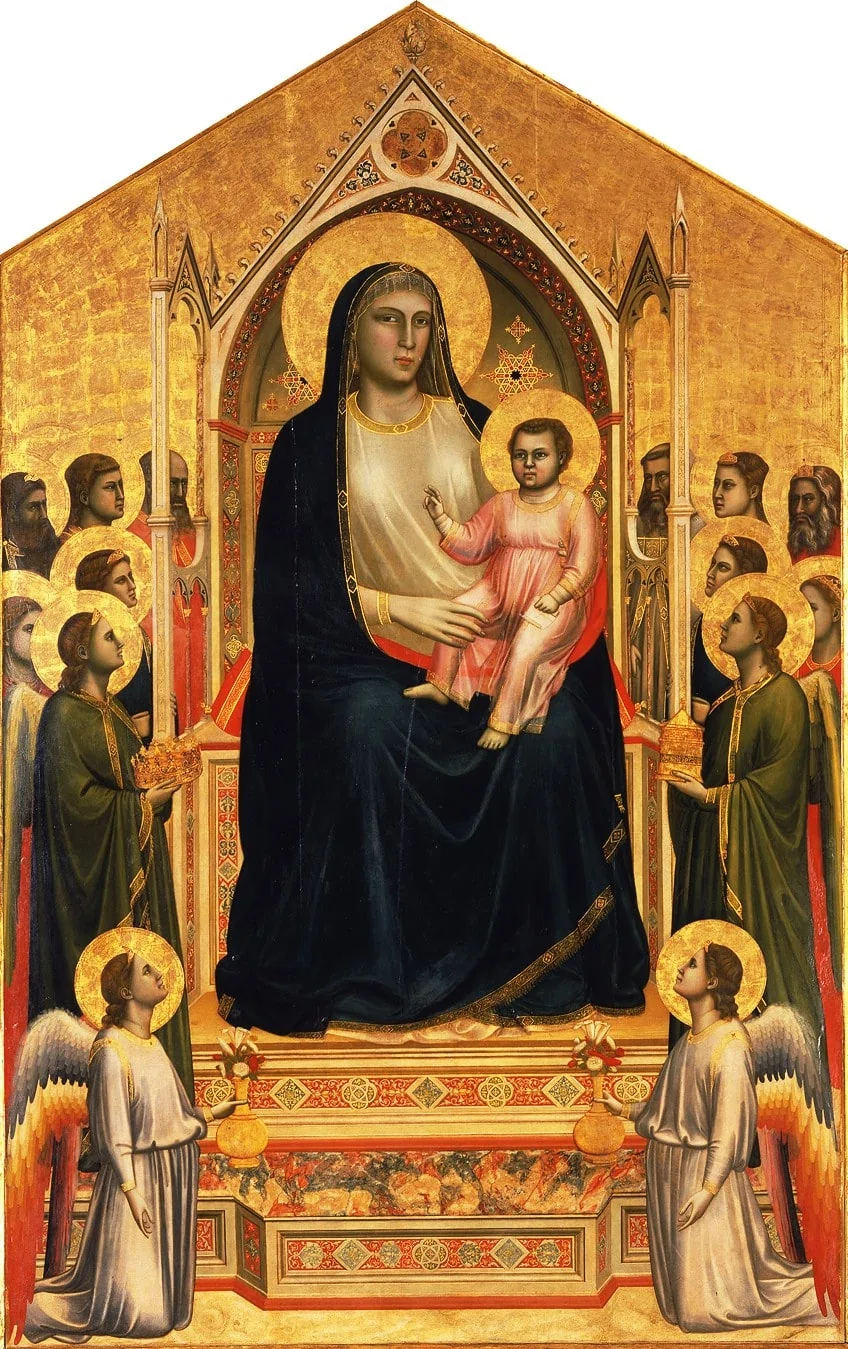
Ognissanti Madonna was created in such a way that the Madonna and Christ child were made in the foreground and were made much bigger than the surrounding figures. Madonna’s throne was created with a technique based on a style known as cosmitesque, which entailed decorating the throne with colored marble. The composition of the piece is symmetrical, and the figures are three-dimensional and tranquil-looking. The space is taken up by the figures which emphasized the importance of the figures in this piece.
Ognissanti Madonna was the first painting that portrayed the Madonna and Christ child taking up real well-defined space to be seen more as human.
Descent from the Cross (1435) by Rogier van der Weyden
| Artist | Rogier van der Weyden (1399 – 1464) |
| Date Painted | 1435 |
| Medium | Oil on oak |
| Dimensions of Artwork | 261.5 cm x 204.5 cm |
| Where It Is Currently Housed | Museo del Prado, Madrid |
| Actual Price | Unknown |
Descent from the Cross was created by Belgian-Flemish artist Rogier van der Weyden. This scene depicts the crucified Christ being lowered from the cross with his body being held by Joseph of Arimathea and Nicodemus. The date of the artwork was estimated based on the style of the painting itself.
The work was created by Rogier van der Weyden to establish a worldwide reputation. This painting is arguably the most influential depiction of Christ’s crucifixion.
The artwork has an incredible emotional impact on the viewer as we see mourning faces surrounding Christ’s lifeless body. The story of the descent from the cross is that of the Entombment of Christ, which is the burial of the body of Jesus after the crucifixion described in the New Testament. The artwork has been extremely influential and often copied into other artworks. In the group of figures, the fainted Virgin Mary stands out, creating a theatrical air. The two figures holding Christ’s body are consumed with tears. The figures are life-sized, leaving an even larger impact on the viewer.
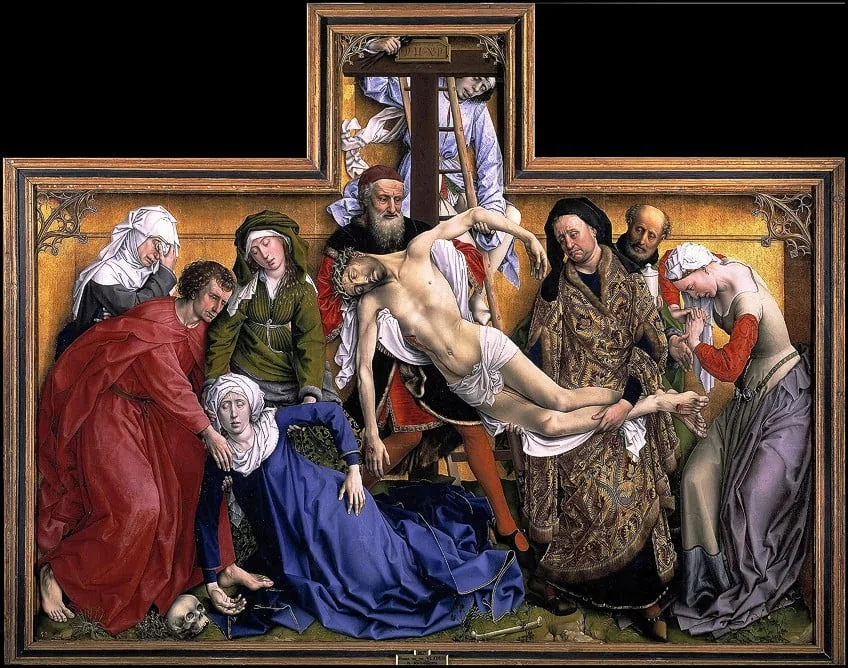
The colors are rich and full of life with an illusionistic space created throughout with the use of placing figures at different depths also known as foreshortening. The Virgin Mary and Christ’s hands are closely met which emphasizes the link between the two.
Many versions have since been created of Christ’s descent from the cross, but The Descent from the Cross by Rogier van der Weyden remains the most famous and influential.
Baptism of Christ (1470 – 1475) by Andrea del Verrocchio and Leonardo da Vinci
| Artist | Andrea del Verrocchio (1435 – 1488) and Leonardo da Vinci (1452 – 1519) |
| Date Painted | 1470 – 1475 |
| Medium | Oil on wood |
| Dimensions of Artwork | 1,77 m x 1.51 m |
| Where It Is Currently housed | Uffizi Gallery, Florence |
| Actual Price | Unknown |
The Baptism of Christ is a painting created by Andrea del Verrocchio and his pupil at the time, Leonardo da Vinci. It is speculated that other painters also took part in this artwork. The picture depicts the story of John the Baptist who is baptizing Jesus Christ. Two angels are seen to the left of Christ, which is said to be painted by da Vinci.
The majority of the background is said to be painted by da Vinci as well. Most of this artwork, including Christ and John the Baptist, was painted by Verrocchio.
Both angels kneel whilst one of them holds Jesus’s clothing garment whilst the other has its hands placed upon each other. The angels kneel in front of a palm tree, with the palm tree symbolizing salvation and life. John the Baptist is seen in layered clothing with a halo above his head. In his left hand, he is seen holding a staff with a gold cross on top of it. He pours the cleansed river water over Christ’s head.
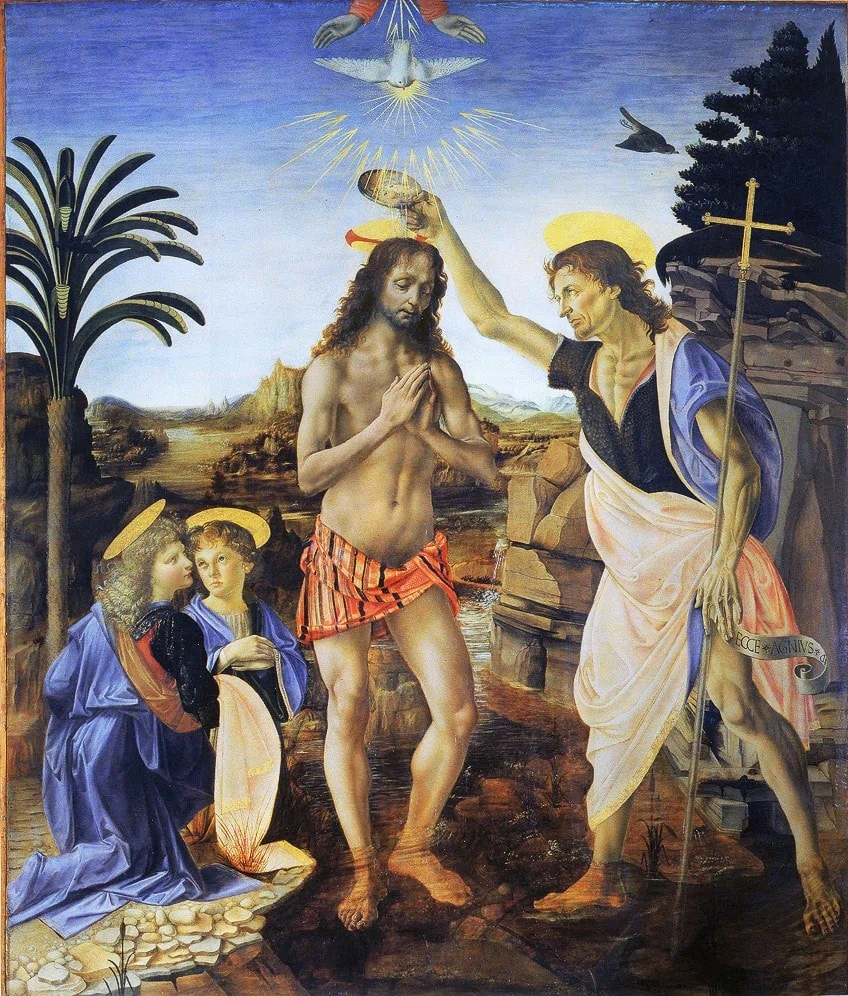
Christ is wearing a modest garment covering his genitals with his pubic hair seen just above the small cloth. From the top of the painting, God’s hands are seen as heaven opens. A white dove is seen flying down from heaven between God’s hands, which is a symbol of the holy spirit. This scene is a depiction of Christ’s divine nature. This artwork is of the Italian Renaissance style.
The painting was ordered to be used by the monks of the San Salvi church as an altarpiece. The painting was created with oil paint which, at the time, was a new medium in use.
The Man of Sorrows in the Arms of a Virgin (1475 – 1479) by Hans Memling
| Artist | Hans Memling (1430 – 1494) |
| Date Painted | 1475 – 1479 |
| Medium | Oil and gold leaf on wood panel |
| Dimensions of Artwork | 27.4 cm x 19.9 cm |
| Where It Is Currently Housed | National Gallery of Victoria, Melbourne |
| Actual Price | Unknown |
The Man of Sorrows in the Arms of a Virgin is a portrait of Christ by Hans Memling created with the intention of it creating and giving off the air of sadness and pity. In this artwork, we see a wounded and bleeding Christ being held in the arms of his mourning mother.
The artwork was made to be used in prayer and for personal use. The scale of the artwork showcases its intention for personal prayer.
The frame of the painting has been changed multiple times as previous frames were thought to be inappropriate for the painting itself. In the background, we see numerous objects and figures, which are all representative of Christ’s journey throughout his life. All these symbols are of passion and pain. The artwork was created in the Northern Renaissance style.
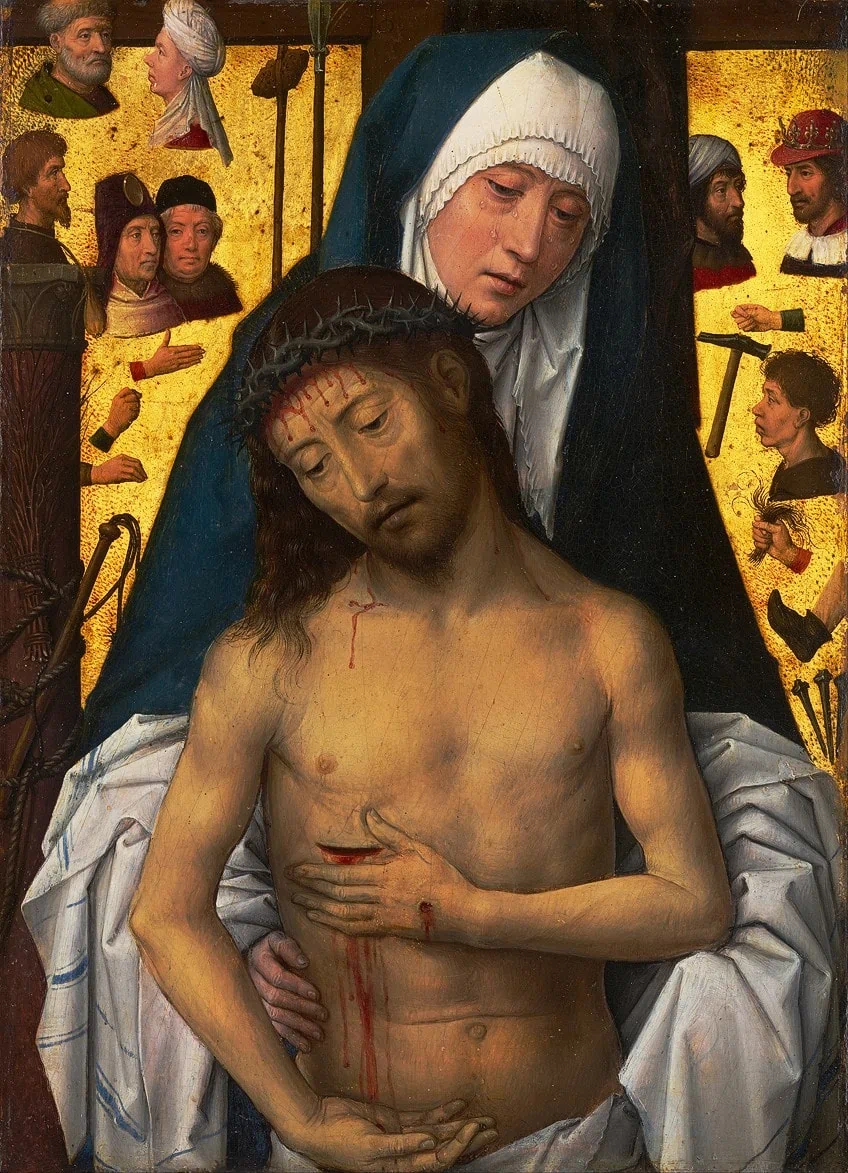
The artwork is rich with passion and intensity. The scene depicted is that of Christ after his crucifixion. Christ’s eyes are slightly opened with an expression of pain and suffering on his face. Christ and his mother’s hands lay closely together beneath the wound on his stomach. Mary is well known in this painting as Our Lady of pity as she holds Christ in her arms. Gold leaf is used in the background of the painting which symbolizes the beauty of heaven, which would be the recompense for prayer toward the painting.
This painting exists as a different representation of Christ than most.
The Last Supper (1495 – 1498) by Leonardo da Vinci
| Artist | Leonardo da Vinci (1452 – 1519) |
| Date Painted | 1495 – 1498 |
| Medium | Tempera on gesso, pitch, and mastic |
| Dimensions of Artwork | 460 cm x 880 cm |
| Where It Is Currently Housed | Santa Maria delle Grazie, Milan |
| Actual Price | $450 Million |
The Last Supper is a mural painting created by Leonardo da Vinci, the Italian High Renaissance artist. The Last Supper is one of da Vinci’s most known and commemorated paintings. It was also incredibly influential as it is said to be the transition of artwork into what is now known as the High Renaissance.
Da Vinci believed in a story told through posture and expression, therefore each of the 12 disciples displayed in the scene was created with a reaction that da Vinci deemed fit for each of the individuals’ personalities.
This led to an outcome of a complex analysis of diverse human reactions in a deceivingly straightforward composition. The Last Supper depicts the scene in which Jesus and his disciples are sharing the final meal in Jerusalem the night before Christ’s crucifixion. This depiction of The Last Supper is closely symbolic of occurrences described in the gospels.

The Last Supper is a tightly arranged scene with Jesus in the middle and his disciples to either side of him. Christ is seen wearing a blue and red robe and is also seen with facial hair. The scene is capturing of the moment of reaction when Jesus reveals the betrayal of one of his disciples. Jesus is calm, which contrasts heavily with the shocked and worried expressions of his disciples.
Today, the painting is only allowed to be viewed in small groups for 15 minutes at a time in order to preserve the fragile artwork. The artwork has inspired many artists and gained much praise.
Disputation of the Holy Sacrament (1509 – 1510) by Raphael
| Artist | Raphael (1483 – 1520) |
| Date Painted | 1509 – 1510 |
| Medium | Fresco |
| Dimensions of Artwork | 500 cm x 770 cm |
| Where It Is Currently Housed | Apostolic Palace, Vatican City |
| Actual Price | Unknown |
The Disputation of the Holy Sacrament was created by Italian Renaissance artist Raphael, which was created between 1509 and 1510. It was commissioned, along with three other frescos, to decorate the rooms of Stanza Della Segnatura, which was the private library where the supreme papal tribunal would meet.
The fresco was created to be a scene of both Heaven and Earth. Above, we see Heaven with Christ surrounded by biblical figures, such as Virgin Mary and John the Baptist.
Surrounding Christ is a halo of light. Above Christ is God the father looking over all the golden light of heaven. The artwork depicts Christianity’s triumph over philosophical thoughts and actions, which was shown in the School of Athens fresco painted on the facing wall.
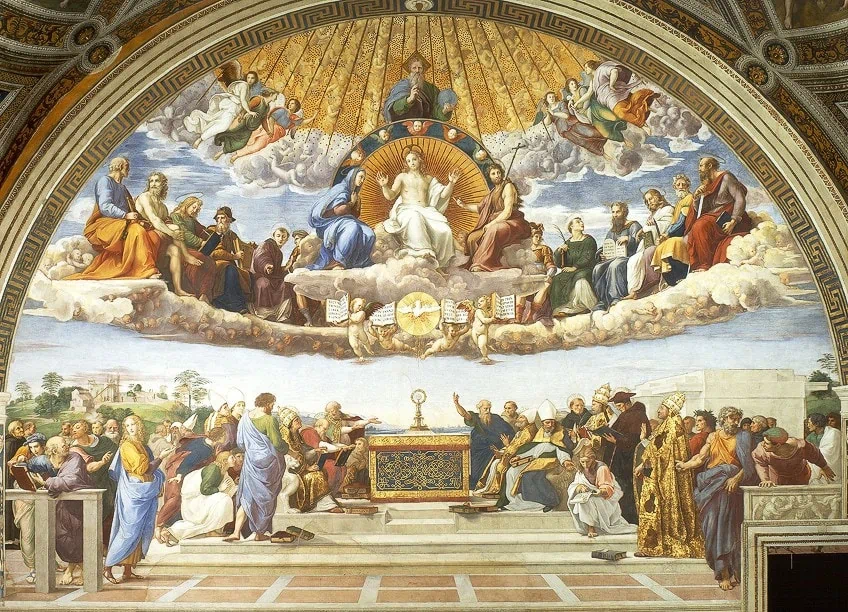
The form of the composition is simple and clear which was attained by Raphael through sketches and studies of posture and form. The artwork is symmetrically balanced and perfect. Below, we see the representatives of the church, some of whom are discussing Christ’s body, blood, soul, and divinity. In the fresco, we see similarities in the figures above and below, as if Heaven is also on Earth.
The hues are bright and saturated, symbolizing the beauty of Heaven and all that has to do with Christ. The fresco is rich in detail and symbolism.
Salvator Mundi (c. 1510) by Leonardo da Vinci
| Artist | Leonardo da Vinci (1452 – 1519) |
| Date Painted | c. 1510 |
| Medium | Oil on walnut panel |
| Dimensions of Artwork | 45.4 cm x 65.6 cm |
| Where It Is Currently Housed | Louvre Abu Dhabi |
| Actual Price | $450 million |
Salvator Mundi, translated to “Savior of the World”, is a portrait of Jesus Christ painted by Italian High Renaissance artist Leonardo da Vinci. The original painting was long thought to be lost and this was speculated as a copy of the original. It was then rediscovered as the original through restoration.
The painting showcases Christ in a blue and gold robe holding a see-through globe in his left hand whilst making the image of the cross with his right. The orb represents the Heavens and his role as the “savior of the world”.
The artwork is said to have been commissioned around 1500 for a specific patron to be used for personal devotion. The unknown patron is speculated to be King Louis XII of France. In this painting, da Vinci depicted Christ as he is known in the gospel of John 4:14. Christ’s gaze is fixed straight forward at the viewer, creating an intense mood throughout the artwork. Many art historians speculate that the painting is not Leonardo da Vinci’s work, as the glass orb does not reflect light how da Vinci would realistically portray it.
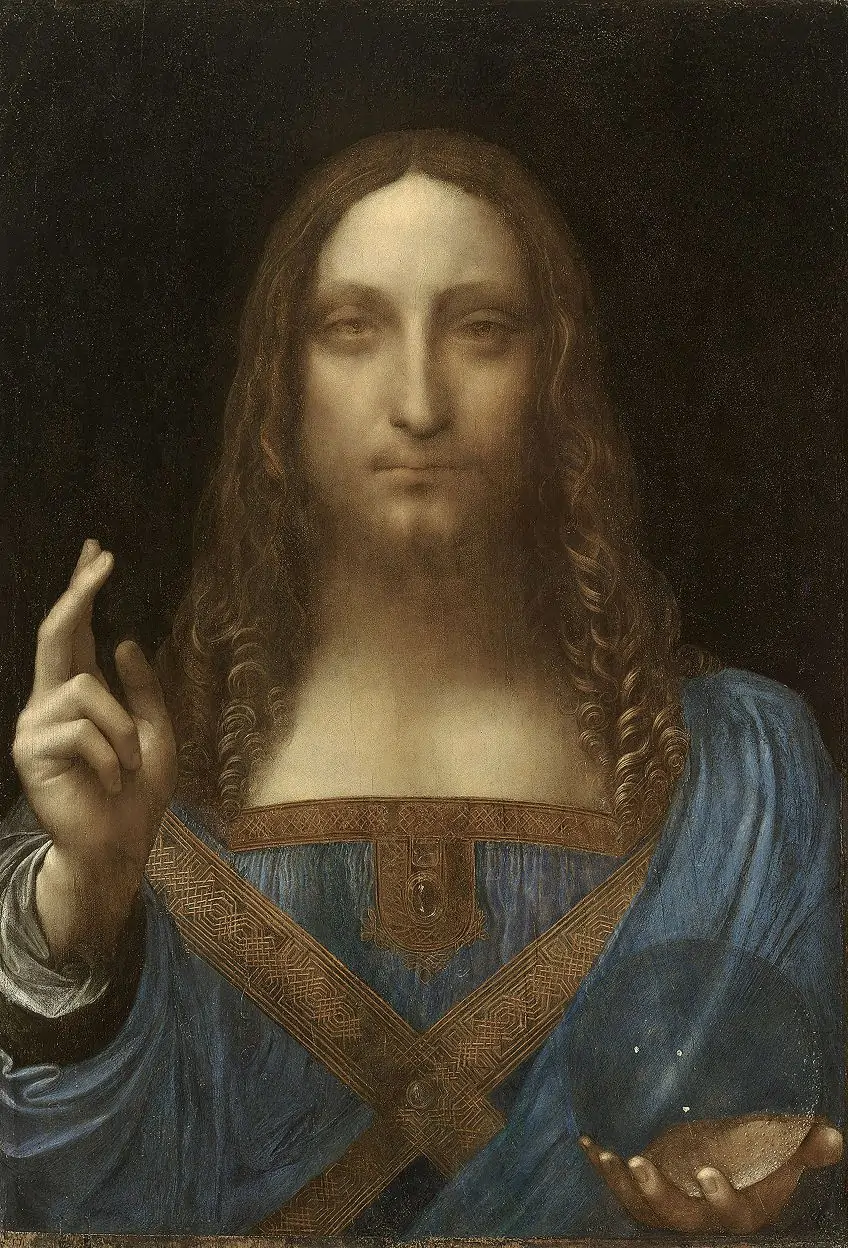
Da Vinci is known to have studied the science of optics, however, it was also speculated that the orb’s lack of distortion was consciously done by the artist. The artwork was created to be utilized as a connection between the spiritual and the viewer. Salvator Mundi is created with the use of Byzantine iconography. After this portrait of Jesus was created, images of Christ holding an orb became widely used.
Christ’s hands are delicately painted, and his complexion is created flawlessly. The background is plain, which enhances the figure of Christ with the bright colors used.
Christ Carrying the Cross (1577 – 1587) by El Greco
| Artist | El Greco (1541 – 1614) |
| Date Painted | 1577 – 1587 |
| Medium | Oil on canvas |
| Dimensions of Artwork | 105 cm x 79 cm |
| Where It Is Currently Housed | Metropolitan Museum of Art, New York |
| Actual Price | Unknown |
Spanish artist El Greco created many portraits of Jesus carrying the cross for the crucifixion. The painting holds a lot of emotion, as Christ is in a deep moment of personal thought as he carries the cross to the ultimate sacrifice of death for humankind.
The painting was inspired by artist Michelangelo and his sculpture, Risen Christ (1519 – 1521).
El Greco created this painting in such a way that allows the expression of Christ to be of human emotion rather than divine. Christ is seen looking up to the heavens with a sense of acceptance and understanding of his fate. His eyes seem to be aching with emotion with tears coming out. The tears symbolize the human emotion in Christ.
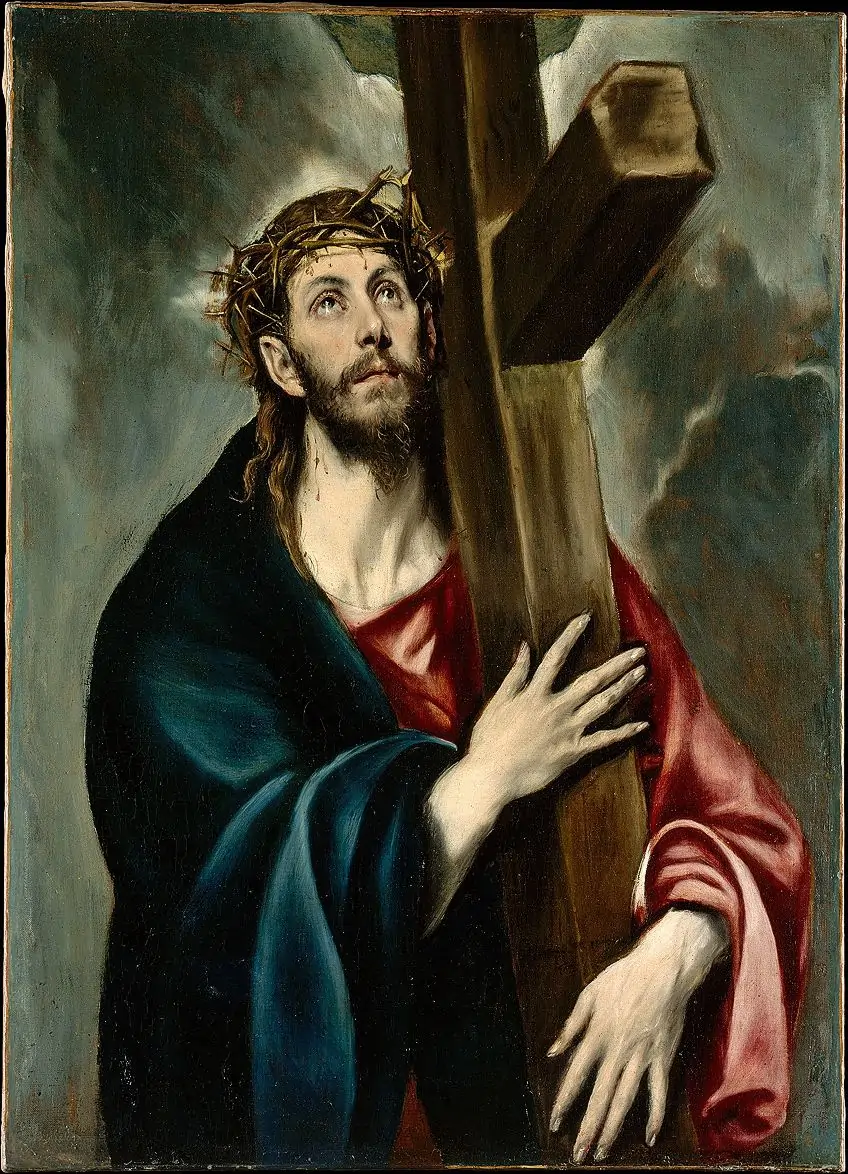
In this narration of Christ’s way to Calvary, we see Christ in an isolated moment during a storm carrying his cross on the way to his crucifixion, pleading for mercy with an understanding of God’s plan for his role ultimate sacrifice for the forgiveness of humankind and their sins. On top of Christ’s head is a crown of thorns which symbolizes Christ dying as a savior and a king.
The thorns are creating wounds on his head that are bleeding, which symbolizes his suffering leading up to his crucifixion.
The background consists of a whirring storm with dark-colored clouds increasing the serious mood surrounding the painting. The storm is also associated with the emotion of fear and anxiety depicted on Christ’s face. In the storm, breaks of light are seen, which symbolizes the acceptance that Christ has for his fate as he reflects towards the Heavens. This painting of Christ is a perfect depiction of religious imagery.
Christ Crucified (1632) by Diego Velázquez
| Artist | Diego Velázquez (1599 – 1660) |
| Date Painted | 1632 |
| Medium | Oil on canvas |
| Dimensions of Artwork | 249 cm x 170 cm |
| Where It Is Currently Housed | Museo del Prado, Madrid |
| Actual Price | Unknown |
Christ Crucified is a painting of Christ during his crucifixion, painted by Spanish artist, Diego Velázquez. The painting was created with inspiration from Velázquez’s nude studies. Christ is depicted with his feet together and his arms apart, nail to a small wooden cross.
The loincloth worn is painted small to show as much nudity as possible. A small halo is shining as if it has protruded from Christ himself.
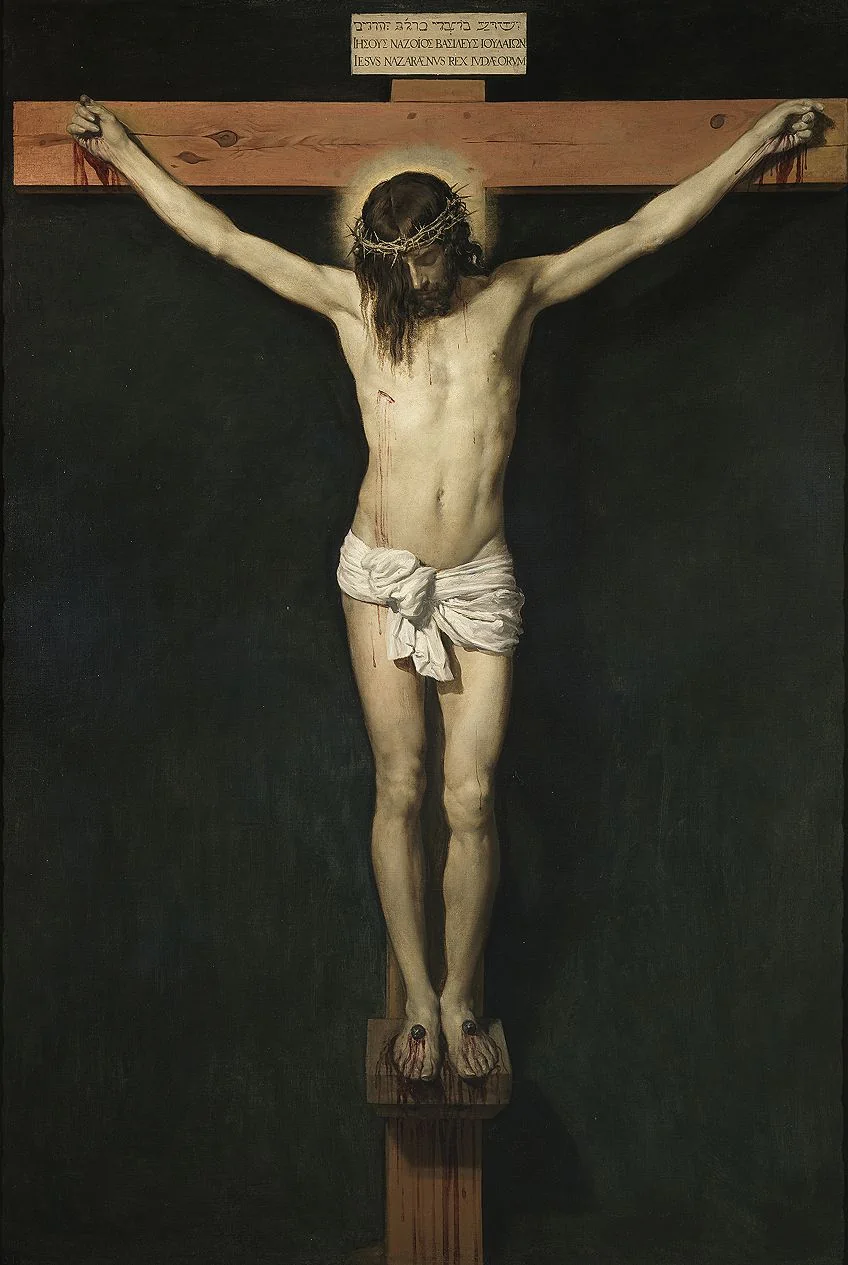
His head is resting down on his chest, showing acceptance toward his fate and also revealing some of his features. His hair covers the majority of the right side of his face. A wound is seen on the right side of his body. This portrait of Jesus created by Diego Velázquez is unique as it consists of many of the different studies and styles that he acquired. The composition is striking, as the dark background and pale skin of Christ contrast against each other. Christ Crucified is compositionally simple, yet it leaves a strong impression behind.
Christ Crucified is, to this day, influential and has left a legacy. This painting has inspired many religious writings and artworks.
Christ in the Realm of the Dead (1891 – 1894) by Joakim Skovgaard
| Artist | Joakim Skovgaard (1856 – 1933) |
| Date painted | 1891 – 1894 |
| Medium | Oil on canvas |
| Dimensions of Artwork | 352 cm x 489 cm |
| Where It Is Currently Housed | Statens Museum for Kunst, Copenhagen |
| Actual Price | Unknown |
In Christ in the Realm of the Dead by Joakim Skovgaard, we see Jesus entering the realm of the dead as a God with the power to redeem and save mankind from its sins. Skovgaard created his work to compel those to the word of God. In this artwork, the story depicted is that of Christ entering the realm of the dead after his crucifixion on the eve of Easter.
In the front of the crowd, we see Adam and Eve, as well as nameless souls reaching out to Jesus, surrounded by bright holy light. To the left, we see a dark figure fleeing the light.
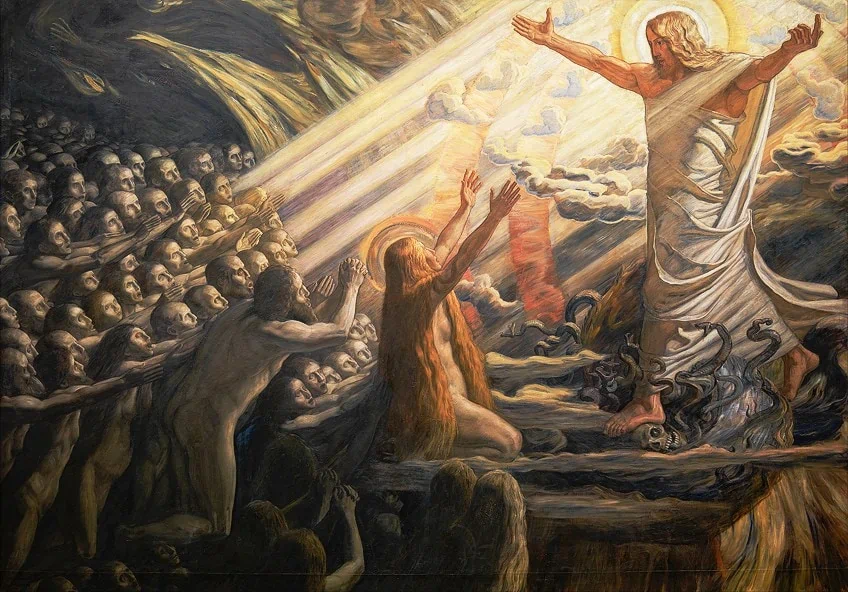
With Christ’s entering the realm of the dead, we see the souls long shrouded in darkness finally being saved by a glorious light that is Christ. The color allows for dramatic emotion throughout the artwork with the busy and emotional composition. The poses of the figures show the human form with detail and modesty. The colors on the rise of the artwork are bright and intense, contrasting with the duller coloring on the left-hand side. This symbolizes the glory and light that Christ is bringing forth to the sad and morose realm of the dead.
These paintings of Jesus are just 10 of many that tell a story of the journey of Christ on Heaven and Earth. These are 10 of the most famous paintings of Jesus that, to this day, are still admired and are of influence to many other artworks of Christ. Many of these artworks were found and never sold, as many of their prices are unknown. We hope that you found this interesting and that you delve deeper into the world of religious artworks of Christ.
Take a look at our Jesus painting webstory here!
Frequently Asked Questions
How Does Art Show Jesus?
Jesus is depicted mainly in two different ways: either with him crucified on the cross, or on his judgment seat. Jesus showcased on the cross gave rise to the symbol of the crucifix (the depiction of Jesus on the cross), which became an important symbol of Jesus in the Roman Catholic Church.
What Is the Oldest Painting of Jesus?
The oldest painting of Jesus was found in Syria and is said to have been created around 235 (late 4th century). The painting portrays Jesus as a young man without a beard. He is shown in the style and dress of a young philosopher with an authoritative stance.
What Did Jesus Really Look Like?
In revelation 1:14 – 15, Jesus is described to have a complexion of a darker tone and that his hair was wooly in appearance. However, throughout the ages in paintings, Jesus has been portrayed as a white European male.
Jordan Anthony is a Cape Town-based film photographer, curator, and arts writer. She holds a Bachelor of Art in Fine Arts from the University of the Witwatersrand, Johannesburg, where she explored themes like healing, identity, dreams, and intuitive creation in her Contemporary art practice. Jordan has collaborated with various local art institutions, including the KZNSA Gallery in Durban, the Turbine Art Fair, and the Wits Art Museum. Her photography focuses on abstract color manipulations, portraiture, candid shots, and urban landscapes. She’s intrigued by philosophy, memory, and esotericism, drawing inspiration from Surrealism, Fluxus, and ancient civilizations, as well as childhood influences and found objects. Jordan is working for artfilemagazine since 2022 and writes blog posts about art history and photography.
Learn more about Jordan Anthony and about us.
Cite this Article
Jordan, Anthony, “Famous Paintings of Jesus – The Top Jesus Paintings in Art History.” artfilemagazine – Your Online Art Source. August 26, 2022. URL: https://artfilemagazine.com/famous-paintings-of-jesus/
Anthony, J. (2022, 26 August). Famous Paintings of Jesus – The Top Jesus Paintings in Art History. artfilemagazine – Your Online Art Source. https://artfilemagazine.com/famous-paintings-of-jesus/
Anthony, Jordan. “Famous Paintings of Jesus – The Top Jesus Paintings in Art History.” artfilemagazine – Your Online Art Source, August 26, 2022. https://artfilemagazine.com/famous-paintings-of-jesus/.


